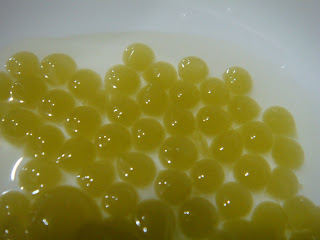As far as I am concerned, I am so very excited with spherification. I know, I know. I'm like 7 years late, but who cares?
Just for additional information, spherification of liquids creates a product that has texture similar to caviar, and thus they are often called 'faux caviar'.
Just for additional information, spherification of liquids creates a product that has texture similar to caviar, and thus they are often called 'faux caviar'.
So I tried using orange juice at first. I've seen people blogging saying that you have to increase the pH if it's too low, but curiosity always comes first. It failed miserably, and the sodium alginate precipitates out :(
I don't have any other liquids at home to experiment with, so I tried using green tea powder in water.
First problem: I don't have a weighing balance, so I just approximated the amounts. THIS TURNED OUT TO BE A VERY BAD IDEA. When I tried my product I could feel extreme bitterness, which I found out is caused by excessive calcium.
Second problem: I don't have good hand controls, so I couldn't shape the caviars well. Some of them looked like biconcaved red blood cells (LOL).
Third problem: the green tea powder doesn't really dissolve in water, so as the result, the liquid within the green tea caviar became rather grainy. Eww.
I wish I had bought sodium citrate or reverse spherification kit instead of just the conventional spherification kit :'(
















Someone just made this with mint tea for the chem banquet at school and i found this page while trying to figure out how she did it. But yeah she used normal tea and it worked!
ReplyDeleteYeah, tea should work well enough because it's not acidic enough to make the sodium alginate coagulate :)
ReplyDeleteMint tea caviar sounds good! Did you eat them along with something else?